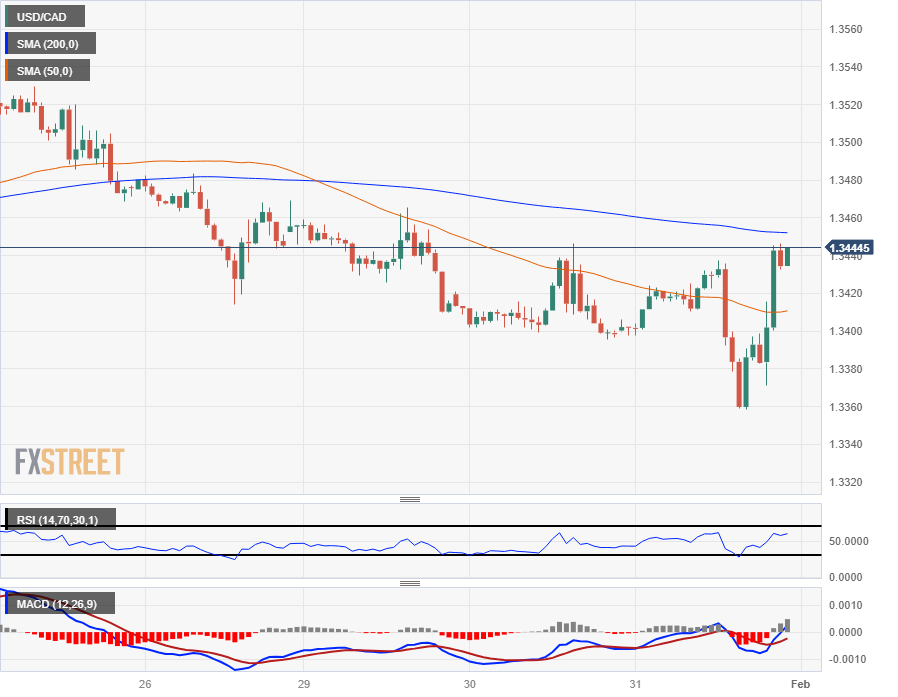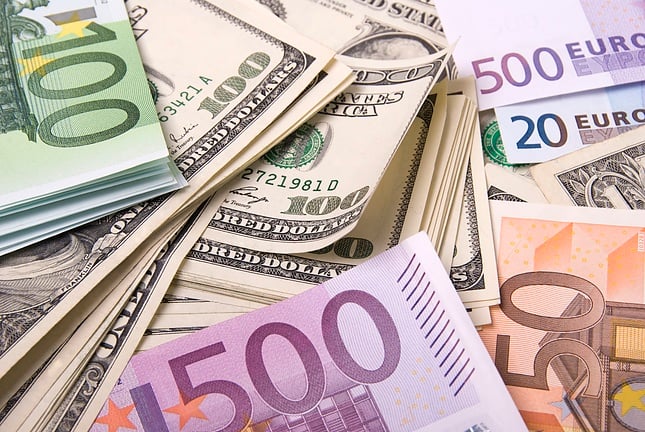Most recent article: Canadian Dollar recovers on Thursday in pre-NFP market churn
- The Canadian Dollar recovered some ground after GDP surprised to the upside.
- Canada saw 0.2% GDP growth in November, which beat consensus.
- Fed rate call, Powell press conference keeps market appetite in the midrange.
The Canadian Dollar (CAD) edged higher on Wednesday after Canadian Gross Domestic Product (GDP) figures beat expectations to post growth for the first time since May. The Federal Reserve (Fed) kept its main policy rate unchanged as markets broadly expected, and Fed Chairman Jerome Powell stressed the need for better indications that US inflation will continue down to the Fed's 2% target and remain at that level. Despite the middling outlook from Fed chair Powell on uncertain economic data, markets pulled back on risk appetite as the Fed puts the final nail in the coffin on a March rate cut.
Canada saw growth in its MoM GDP for the first time in seven months on Wednesday, sending the Canadian Dollar into recovery mode against the US Dollar (USD), but the CAD still remains in the red against several of its major currency peers. Loonie traders will be looking ahead to Thursday’s January Canadian Purchasing Managers Index (PMI) figures for Canada’s manufacturing sector after the Fed rate call dust settles.
Daily digest market movers: Canadian Dollar surges against the Greenback on GDP growth
- Canadian November GDP growth was a surprise on Wednesday, coming in at 0.2% MoM versus the forecast of 0.1%.
- Canadian GDP printed above 0.0% for the first time in seven months after revisions.
- S&P Global’s Canadian Manufacturing PMI for January is due Thursday, last MoM Manufacturing PMI printed in contraction territory at 45.4.
- Jerome Powell explains decision to keep policy rate unchanged.
- Investors will be looking for hints about when the Fed will cut rates.
- Rate swap bets on a Fed cut in March lurched higher early Wednesday, now pricing in 65% chance of at least a 25 basis point rate trim by March 20 meeting.
- CME FedWatch Tool says swap rates are pricing in a less than 5% chance of no rate cuts from the Fed by May.
- The US Dollar backslid after ADP Employment Change figures came in well below expectations and an unexpected backslide in the Chicago PMI.
- ADP Employment Change in January fell to 107K versus the forecast for 145K, December’s 158K (revised down from 164K).
- January’s Chicago PMI declined to 46.0 instead of the forecasted uptick to 48.0 against December’s 47.2 (revised up from 46.9).
- Volatile ADP figures are prone to steep revisions and has a sketchy-at-best track record for previewing the US Nonfarm Payrolls (NFP) print slated for Friday.
- ADP Employment Change has seen revisions in all but a single month since 2007.
Canadian Dollar price today
The table below shows the percentage change of Canadian Dollar (CAD) against listed major currencies today. Canadian Dollar was the strongest against the Australian Dollar.
| USD | EUR | GBP | CAD | AUD | JPY | NZD | CHF | |
| USD | 0.23% | 0.06% | 0.24% | 0.43% | -0.28% | 0.23% | -0.06% | |
| EUR | -0.22% | -0.18% | 0.01% | 0.20% | -0.50% | 0.00% | -0.29% | |
| GBP | -0.06% | 0.17% | 0.19% | 0.36% | -0.34% | 0.17% | -0.10% | |
| CAD | -0.24% | -0.01% | -0.21% | 0.17% | -0.52% | -0.02% | -0.30% | |
| AUD | -0.41% | -0.18% | -0.36% | -0.17% | -0.70% | -0.18% | -0.47% | |
| JPY | 0.29% | 0.51% | 0.32% | 0.51% | 0.74% | 0.50% | 0.23% | |
| NZD | -0.24% | 0.03% | -0.18% | 0.01% | 0.19% | -0.52% | -0.28% | |
| CHF | 0.06% | 0.28% | 0.10% | 0.30% | 0.46% | -0.23% | 0.28% |
The heat map shows percentage changes of major currencies against each other. The base currency is picked from the left column, while the quote currency is picked from the top row. For example, if you pick the Euro from the left column and move along the horizontal line to the Japanese Yen, the percentage change displayed in the box will represent EUR (base)/JPY (quote).
Technical Analysis: Canadian Dollar climbs over the Greenback on Canadian GDP upshot
The Canadian Dollar (CAD) saw early gains on Wednesday, but fell back after broader markets pivoted into the Greenback, sending the Canadian Dollar down to be one of the worst-performing major currencies of the day. The Canadian Dollar shed a quarter of a percent against the Greenback, gaining ground only against the Australian Dollar (AUD), climbing a fifth of a percent over the beleaguered Antipodean.
USD/CAD tumbled to 1.3360 in early US trading, falling 0.6% from the day’s peak of 1.3437. Intraday momentum is dragging the pair back into the 1.3400 handle after the Fed's rate call, and investors will be bracing for whips in the USD/CAD.
After broad-market sentiment pivoted post-Fed, the USD/CAD rallied to end Wednesday in the green, pinning daily candlesticks back into near-term technical resistance at the 50-day SMA near 1.3440.
USD/CAD Hourly Chart
USD/CAD Daily Chart
Canadian Dollar FAQs
What key factors drive the Canadian Dollar?
The key factors driving the Canadian Dollar (CAD) are the level of interest rates set by the Bank of Canada (BoC), the price of Oil, Canada’s largest export, the health of its economy, inflation and the Trade Balance, which is the difference between the value of Canada’s exports versus its imports. Other factors include market sentiment – whether investors are taking on more risky assets (risk-on) or seeking safe-havens (risk-off) – with risk-on being CAD-positive. As its largest trading partner, the health of the US economy is also a key factor influencing the Canadian Dollar.
How do the decisions of the Bank of Canada impact the Canadian Dollar?
The Bank of Canada (BoC) has a significant influence on the Canadian Dollar by setting the level of interest rates that banks can lend to one another. This influences the level of interest rates for everyone. The main goal of the BoC is to maintain inflation at 1-3% by adjusting interest rates up or down. Relatively higher interest rates tend to be positive for the CAD. The Bank of Canada can also use quantitative easing and tightening to influence credit conditions, with the former CAD-negative and the latter CAD-positive.
How does the price of Oil impact the Canadian Dollar?
The price of Oil is a key factor impacting the value of the Canadian Dollar. Petroleum is Canada’s biggest export, so Oil price tends to have an immediate impact on the CAD value. Generally, if Oil price rises CAD also goes up, as aggregate demand for the currency increases. The opposite is the case if the price of Oil falls. Higher Oil prices also tend to result in a greater likelihood of a positive Trade Balance, which is also supportive of the CAD.
How does inflation data impact the value of the Canadian Dollar?
While inflation had always traditionally been thought of as a negative factor for a currency since it lowers the value of money, the opposite has actually been the case in modern times with the relaxation of cross-border capital controls. Higher inflation tends to lead central banks to put up interest rates which attracts more capital inflows from global investors seeking a lucrative place to keep their money. This increases demand for the local currency, which in Canada’s case is the Canadian Dollar.
How does economic data influence the value of the Canadian Dollar?
Macroeconomic data releases gauge the health of the economy and can have an impact on the Canadian Dollar. Indicators such as GDP, Manufacturing and Services PMIs, employment, and consumer sentiment surveys can all influence the direction of the CAD. A strong economy is good for the Canadian Dollar. Not only does it attract more foreign investment but it may encourage the Bank of Canada to put up interest rates, leading to a stronger currency. If economic data is weak, however, the CAD is likely to fall.
Information on these pages contains forward-looking statements that involve risks and uncertainties. Markets and instruments profiled on this page are for informational purposes only and should not in any way come across as a recommendation to buy or sell in these assets. You should do your own thorough research before making any investment decisions. FXStreet does not in any way guarantee that this information is free from mistakes, errors, or material misstatements. It also does not guarantee that this information is of a timely nature. Investing in Open Markets involves a great deal of risk, including the loss of all or a portion of your investment, as well as emotional distress. All risks, losses and costs associated with investing, including total loss of principal, are your responsibility. The views and opinions expressed in this article are those of the authors and do not necessarily reflect the official policy or position of FXStreet nor its advertisers. The author will not be held responsible for information that is found at the end of links posted on this page.
If not otherwise explicitly mentioned in the body of the article, at the time of writing, the author has no position in any stock mentioned in this article and no business relationship with any company mentioned. The author has not received compensation for writing this article, other than from FXStreet.
FXStreet and the author do not provide personalized recommendations. The author makes no representations as to the accuracy, completeness, or suitability of this information. FXStreet and the author will not be liable for any errors, omissions or any losses, injuries or damages arising from this information and its display or use. Errors and omissions excepted.
The author and FXStreet are not registered investment advisors and nothing in this article is intended to be investment advice.
Recommended content
Editors’ Picks

EUR/USD holds steady near 1.0500 ahead of FOMC Minutes
EUR/USD trades marginally higher on the day near 1.0500. The US Dollar struggles to preserve its strength amid a modest improvement seen in risk sentiment, helping EUR/USD hold its ground before the Fed publishes the minutes of the November policy meeting.

GBP/USD struggles to hold above 1.2600
GBP/USD loses its traction and trades below 1.2600 after rising above this level earlier in the day. Nevertheless, the pair's losses remain limited as the US Dollar struggles to find demand following mixed data releases. Markets await FOMC Minutes.

Gold stabilizes above $2,600 after sell-off on hope of ceasefire in Lebanon
Gold fluctuates above $2,600 on Tuesday after sliding almost three percent – a whopping $90 plus – on Monday due to rumors Israel and Hezbollah were on the verge of agreeing on a ceasefire. Whilst good news for Lebanon, this was not good news for Gold as it improved the outlook for geopolitical risk.

Trump shakes up markets again with “day one” tariff threats against CA, MX, CN
Pres-elect Trump reprised the ability from his first term to change the course of markets with a single post – this time from his Truth Social network; Threatening 25% tariffs "on Day One" against Mexico and Canada, and an additional 10% against China.

Eurozone PMI sounds the alarm about growth once more
The composite PMI dropped from 50 to 48.1, once more stressing growth concerns for the eurozone. Hard data has actually come in better than expected recently – so ahead of the December meeting, the ECB has to figure out whether this is the PMI crying wolf or whether it should take this signal seriously. We think it’s the latter.

Best Forex Brokers with Low Spreads
VERIFIED Low spreads are crucial for reducing trading costs. Explore top Forex brokers offering competitive spreads and high leverage. Compare options for EUR/USD, GBP/USD, USD/JPY, and Gold.